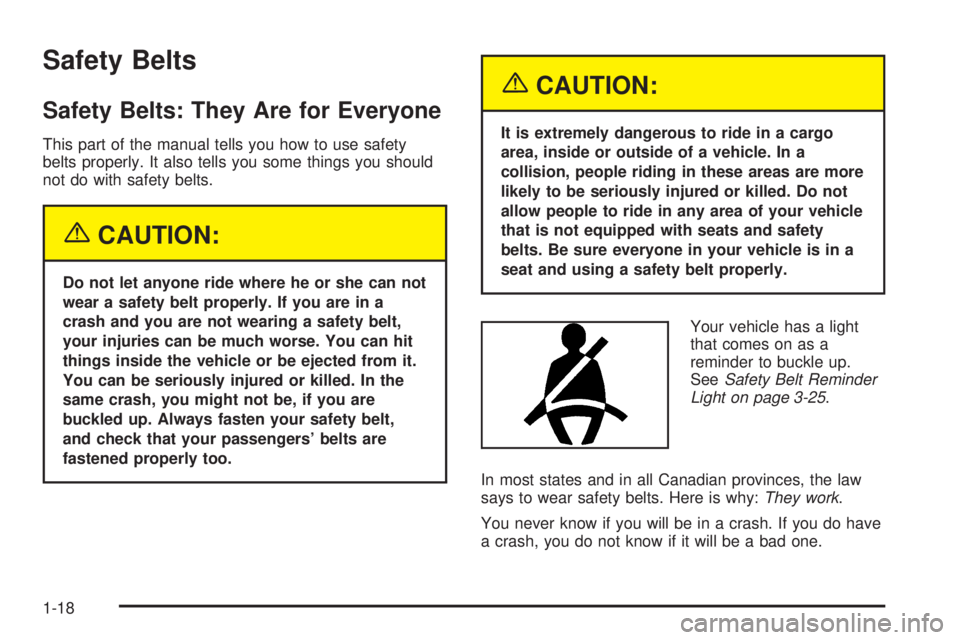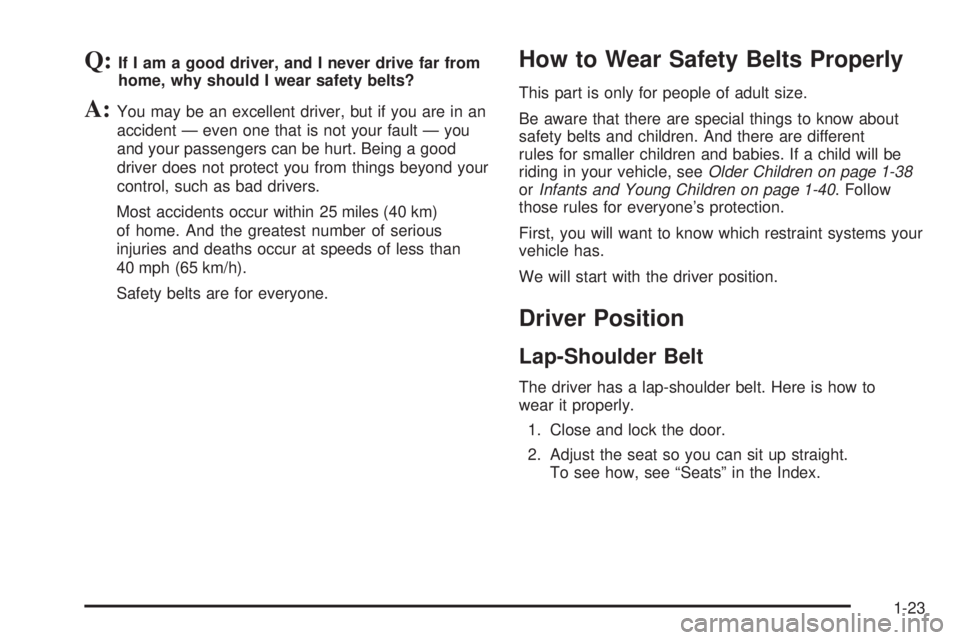Page 17 of 376

If you installed the safety belt with the release hole facing
inward (toward the seat), slide the plastic cover up so you
can see the buckle. Disconnect the seat belt. Slide the
cover back down and reinstall the belt correctly.
{CAUTION:
A safety belt that is improperly routed, not
properly attached, or twisted will not provide
the protection needed in a crash. The person
wearing the belt could be seriously injured.
After raising the rear seatback, always check
to be sure that the safety belts are properly
routed and attached, and are not twisted.
Bench Seat
Each bench seat can carry up to three passengers.
They can also be removed to increase storage space.
See “Removing the Rear Seats” following.
Only the third row bench seat can be adjusted forward
or rearward.Move the seat adjustment
lever located at the front
of the seat toward the
passenger’s side to unlock
it. Slide the seat to
where you want it and
release the lever. Try to
move the seat with
your body, to make sure
the seat is locked into
place.
The center bench seat has a pivoting right armrest.
The optional bench seats come with moveable armrests,
individual reclining seatbacks, adjustable headrests
and a fold-down center armrest console.
1-11
Page 19 of 376
To raise the seatback, do the following
1. Unlock the seatback lever by pulling up on the lever
while pushing down on the upper edge of the
seatback.
2. Move the seatback into the upright position.
3. Make sure the seatback is locked when it is back
in the upright position.
{CAUTION:
If the seatback is not locked, it could move
forward in a sudden stop or crash. That could
cause injury to the person sitting there. Always
press rearward on the seatback to be sure it
is locked.
Removing the Rear Seats
To remove the rear bench seats, do the following:
1. If you are removing
the center seat,
remove the right
lap-shoulder belt.
To do this, press
the tip of a key into
the release hole of the
safety belt attachment
while pulling up on
the safety belt.
1-13
Page 21 of 376
6. Lift up on the rear of the seat to remove the seat
assembly from the rear latch pins. Then, pull the
whole seat back to remove the seat from the
front retainers and then lift the seat out of the
vehicle.
Reinstalling the Rear Seats
1. Lower the seat into position. Make sure the front
retainers are hooked onto the anchor pins.
1-15
Page 23 of 376
5. If you installed the safety belt with the release hole
facing inward (toward the seat), slide the plastic
cover up so you can see the buckle. Disconnect the
seat belt. Slide the cover back down and reinstall
the belt correctly.
{CAUTION:
A safety belt that is improperly routed, not
properly attached, or twisted will not provide
the protection needed in a crash. The person
wearing the belt could be seriously injured.
After raising the rear seatback, always check
to be sure that the safety belts are properly
routed and attached, and are not twisted.
Bucket Seats
Your vehicle may have rear bucket seats with an
adjustment release bar located under the front of the
seats. These seats can be adjusted forward or rearward
with the release bar. Pull the release bar up to release
the seat bottom. Slide the seat where you want it
and then let go of the release bar. Then try to move the
seat with your body to make sure the seat is locked
into place.
1-17
Page 24 of 376

Safety Belts
Safety Belts: They Are for Everyone
This part of the manual tells you how to use safety
belts properly. It also tells you some things you should
not do with safety belts.
{CAUTION:
Do not let anyone ride where he or she can not
wear a safety belt properly. If you are in a
crash and you are not wearing a safety belt,
your injuries can be much worse. You can hit
things inside the vehicle or be ejected from it.
You can be seriously injured or killed. In the
same crash, you might not be, if you are
buckled up. Always fasten your safety belt,
and check that your passengers’ belts are
fastened properly too.
{CAUTION:
It is extremely dangerous to ride in a cargo
area, inside or outside of a vehicle. In a
collision, people riding in these areas are more
likely to be seriously injured or killed. Do not
allow people to ride in any area of your vehicle
that is not equipped with seats and safety
belts. Be sure everyone in your vehicle is in a
seat and using a safety belt properly.
Your vehicle has a light
that comes on as a
reminder to buckle up.
SeeSafety Belt Reminder
Light on page 3-25.
In most states and in all Canadian provinces, the law
says to wear safety belts. Here is why:They work.
You never know if you will be in a crash. If you do have
a crash, you do not know if it will be a bad one.
1-18
Page 29 of 376

Q:If I am a good driver, and I never drive far from
home, why should I wear safety belts?
A:You may be an excellent driver, but if you are in an
accident — even one that is not your fault — you
and your passengers can be hurt. Being a good
driver does not protect you from things beyond your
control, such as bad drivers.
Most accidents occur within 25 miles (40 km)
of home. And the greatest number of serious
injuries and deaths occur at speeds of less than
40 mph (65 km/h).
Safety belts are for everyone.
How to Wear Safety Belts Properly
This part is only for people of adult size.
Be aware that there are special things to know about
safety belts and children. And there are different
rules for smaller children and babies. If a child will be
riding in your vehicle, seeOlder Children on page 1-38
orInfants and Young Children on page 1-40. Follow
those rules for everyone’s protection.
First, you will want to know which restraint systems your
vehicle has.
We will start with the driver position.
Driver Position
Lap-Shoulder Belt
The driver has a lap-shoulder belt. Here is how to
wear it properly.
1. Close and lock the door.
2. Adjust the seat so you can sit up straight.
To see how, see “Seats” in the Index.
1-23
Page 40 of 376
Center Rear Passenger Position
Lap Belt
If your vehicle has rear bench seats, someone can sit
in the center positions.
When you sit in a center seating position, you have a
lap safety belt, which has no retractor. To make the belt
longer, tilt the latch plate and pull it along the belt.To make the belt shorter, pull its free end as shown
until the belt is snug. Buckle, position and release it the
same way as the lap part of a lap-shoulder belt. If
the belt is not long enough, seeSafety Belt Extender
on page 1-37.
Make sure the release button on the buckle is positioned
so you would be able to unbuckle the safety belt
quickly if you ever had to.
1-34
Page 41 of 376
Rear Safety Belt Comfort Guides
for Children and Small Adults
Rear safety belt comfort guides provide added safety
belt comfort for older children who have outgrown
booster seats and for small adults. When installed on
a shoulder belt, the comfort guide better positions
the belt away from the neck and head.Here is how to install a comfort guide and use the
safety belt:
1. Remove the guide from its storage clip on the side
of the seatback.
1-35